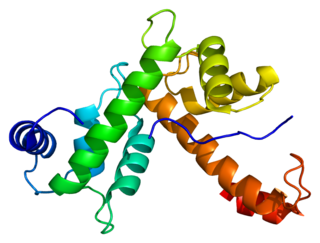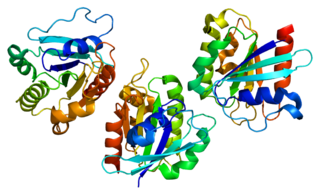| ANXA9 | |||||||||||||||||||||||||||||||||||||||||||||||||||
|---|---|---|---|---|---|---|---|---|---|---|---|---|---|---|---|---|---|---|---|---|---|---|---|---|---|---|---|---|---|---|---|---|---|---|---|---|---|---|---|---|---|---|---|---|---|---|---|---|---|---|---|
| Identifiers | |||||||||||||||||||||||||||||||||||||||||||||||||||
| Aliases | ANXA9 , ANX31, annexin A9 | ||||||||||||||||||||||||||||||||||||||||||||||||||
| External IDs | OMIM: 603319 MGI: 1923711 HomoloGene: 2643 GeneCards: ANXA9 | ||||||||||||||||||||||||||||||||||||||||||||||||||
| |||||||||||||||||||||||||||||||||||||||||||||||||||
| |||||||||||||||||||||||||||||||||||||||||||||||||||
| |||||||||||||||||||||||||||||||||||||||||||||||||||
| |||||||||||||||||||||||||||||||||||||||||||||||||||
| |||||||||||||||||||||||||||||||||||||||||||||||||||
| Wikidata | |||||||||||||||||||||||||||||||||||||||||||||||||||
| |||||||||||||||||||||||||||||||||||||||||||||||||||
Annexin A9 is a protein that in humans is encoded by the ANXA9 gene. [5] [6] [7]
| ANXA9 | |||||||||||||||||||||||||||||||||||||||||||||||||||
|---|---|---|---|---|---|---|---|---|---|---|---|---|---|---|---|---|---|---|---|---|---|---|---|---|---|---|---|---|---|---|---|---|---|---|---|---|---|---|---|---|---|---|---|---|---|---|---|---|---|---|---|
| Identifiers | |||||||||||||||||||||||||||||||||||||||||||||||||||
| Aliases | ANXA9 , ANX31, annexin A9 | ||||||||||||||||||||||||||||||||||||||||||||||||||
| External IDs | OMIM: 603319 MGI: 1923711 HomoloGene: 2643 GeneCards: ANXA9 | ||||||||||||||||||||||||||||||||||||||||||||||||||
| |||||||||||||||||||||||||||||||||||||||||||||||||||
| |||||||||||||||||||||||||||||||||||||||||||||||||||
| |||||||||||||||||||||||||||||||||||||||||||||||||||
| |||||||||||||||||||||||||||||||||||||||||||||||||||
| |||||||||||||||||||||||||||||||||||||||||||||||||||
| Wikidata | |||||||||||||||||||||||||||||||||||||||||||||||||||
| |||||||||||||||||||||||||||||||||||||||||||||||||||
Annexin A9 is a protein that in humans is encoded by the ANXA9 gene. [5] [6] [7]
The annexins are a family of calcium-dependent phospholipid-binding proteins. Members of the annexin family contain 4 internal repeat domains, each of which includes a type II calcium-binding site. The calcium-binding sites are required for annexins to aggregate and cooperatively bind anionic phospholipids and extracellular matrix proteins. This gene encodes a divergent member of the annexin protein family in which all four homologous type II calcium-binding sites in the conserved tetrad core contain amino acid substitutions that ablate their function. However, structural analysis suggests that the conserved putative ion channel formed by the tetrad core is intact. [7]

Annexin A2 also known as annexin II is a protein that in humans is encoded by the ANXA2 gene.

Annexin A5 is a cellular protein in the annexin group. In flow cytometry, annexin V is commonly used to detect apoptotic cells by its ability to bind to phosphatidylserine, a marker of apoptosis when it is on the outer leaflet of the plasma membrane. The function of the protein is unknown; however, annexin A5 has been proposed to play a role in the inhibition of blood coagulation by competing for phosphatidylserine binding sites with prothrombin and also to inhibit the activity of phospholipase A1. These properties have been found by in vitro experiments.

Annexin A6 is a protein that in humans is encoded by the ANXA6 gene.

Programmed cell death protein 6 is a protein that in humans is encoded by the PDCD6 gene.

Probable G-protein coupled receptor 135 is a protein that in humans is encoded by the GPR135 gene.

Annexin A4 is a protein that in humans is encoded by the ANXA4 gene.

Sorcin is a protein that in humans is encoded by the SRI gene.

Annexin A11 is a protein that in humans is encoded by the ANXA11 gene.

Zinc finger protein 281 is a protein that in humans is encoded by the ZNF281 gene.

Annexin A8-like protein 2 is a protein that in humans is encoded by the ANXA8L2 gene.

Alpha-1,3/1,6-mannosyltransferase ALG2 is an enzyme that is encoded by the ALG2 gene. Mutations in the human gene are associated with congenital defects in glycosylation The protein encoded by the ALG2 gene belongs to two classes of enzymes: GDP-Man:Man1GlcNAc2-PP-dolichol alpha-1,3-mannosyltransferase and GDP-Man:Man2GlcNAc2-PP-dolichol alpha-1,6-mannosyltransferase.

ATP-binding cassette sub-family A member 3 is a protein that in humans is encoded by the ABCA3 gene.

ADP-ribosylation factor-like protein 6 is a protein that in humans is encoded by the ARL6 gene.

45 kDa calcium-binding protein is a protein that in humans is encoded by the SDF4 gene.

Synaptotagmin-7 is a protein that in humans is encoded by the SYT7 gene.

Annexin A13 is a protein that in humans is encoded by the ANXA13 gene.

Copine-6 is a protein that in humans is encoded by the CPNE6 gene.

Centromere protein K is a protein that in humans is encoded by the CENPK gene.

Copine-4 is a protein that in humans is encoded by the CPNE4 gene.

Ryanodine receptor 3 is one of a class of ryanodine receptors and a protein that in humans is encoded by the RYR3 gene. The protein encoded by this gene is both a calcium channel and a receptor for the plant alkaloid ryanodine. RYR3 and RYR1 control the resting calcium ion concentration in skeletal muscle.